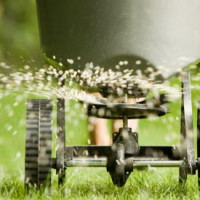Brown Patch Thrives in Summer Time
If you have brown patches mysteriously appearing in your lawn around this time of the year, chance are fairly good that your grass has a fungus commonly referred to as Brown Patch. Brown Patch thrives in hot, humid conditions, exactly the weather we have right now.
How To Recognize Brown Patch
It initially starts out with a slight purple appearance with “smoke ring” edges, turning a dull brown as the diseases progresses. Upon inspection of the blades of grass, one can find tan lesions which may develop reddish-brown margins. Areas that are totally killed by the fungus will appear light brown, or straw colored, and be very brittle to the touch.
Summer is the optimal time for Brown Patch in Montgomery County, Maryland and other Mid-Atlantic areas. It thrives when temperatures are in the range of 75° to 95° F, with the optimal conditions for leaf colonization being temperatures of 85° to 90° F with high humidity or extended leaf wetness periods.
What To Do
Early identification is key to successful treatment. Brown Patch thrives when lawns have excess moisture (overwatering, high rain or humidity), and will continue to spread during the growing season if conditions do not change. Most people will apply fertilizer when they see dying lawn areas but this only fuels the problem.
Controlling the moisture level is important. While we cannot control what nature gives us or the humidity, we can control how much water we apply using sprinklers or irrigation systems. If Brown Patch is a problem, water should only be applied when it is needed. Watering in the early morning will allow the grass to completely dry before evening, thus limiting the amount of time that the lawn is wet. Watering in the late afternoon and evening should always be avoided. Aerating the lawn will allow the water to soak through to the roots faster.

If the disease persists, the use of a fungicide may be necessary to truly fight the fungus. As with all pesticides, it is best to have a trained and licensed applicator apply it. There are several fungicides available to fight Brown Patch. Your lawn care provider will be able to recommend that one that is best for your situation.
Allentuck Landscaping Co. is available for all of your lawn care and landscape needs.
Phone: 3015-515-1900 Email: info@allentucklandscaping.com
Allentuck Landscaping Co. is Your Residential Landscape Company proudly serving Chevy Chase, Bethesda, Potomac, Darnestown, North Potomac, Rockville, Gaithersburg, Boyds, Germantown, Clarksburg, Ijamsville and Urbana.
